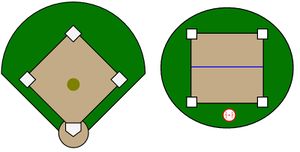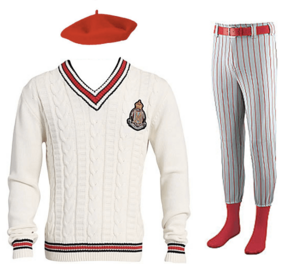Canadian baseball
Canadian baseball is a form of baseball played in Canada in which two teams of ten players take turns batting and fielding.
The camp
Canadian baseball is played on a large field, called a camp, which is usually comprised of grass and dirt.
The batsman (not a batter) stands[1] on the faceoff spot.[2] His objective is to get to a base (pronounced, as in French, bahz) and, if possible, go around all four bases[3] which make up the iconic square (not a diamond).
Due to the layout of the camp, it is much easier to get to first base than it is to get to the other bases, which is curiously not the case with French-Canadian women.
The lancer (not the pitcher)[4] is made to stand (not sit, unless the batsman does) behind the blue line in the centre (not center) of the camp.
Equipment
Teams traditionally played in all whites, as in cricket or boules (bowls). However, in the late 19th century when the sport moved from being played on an all-grass lawn to its more familiar grass and dirt combination, teams started to use grey pants, but maintained the white pullovers. The pullovers tend to be extremely thick due to the icy Canadian temperatures the sport is usually played in, and, according to visiting Americans, make it almost impossible to hit or throw the ball a significant distance.
Like pullovers, long colourful chaussettes (socks) are popular not only for their sense of style they bring to the outfit, but for the crucial role they play in keeping frostbite at bay. The Chaussettes Rouges of Québec sport the most iconic kit (not uniform) in Canada.→
A pétanque style ball leads the observant watcher to realise where Canadian baseball began. Young French Canadian children, bored to death with their grandfathers' endless games of boules started to invent their own game, which involved trying to smash the ball as far away as possible, ideally so it was impossible for their elders to retrieve.
Various different implements were used as the bat, but since the Premier League Baseball (PLB) association was formed in 1908, teams have used a long metal bat – similar in feel and weight to an American baseball bat, but with a form resembling that of a cricket bat.
Campers (the men on the field) do not wear mitts or caps, but rather berets. They tend to catch the ball in their hands, but if they use their beret it counts as two oots.
Rules
The match begins when the lancer throws the ball. He is only allowed to throw underarm. When throwing, he must stand on or behind the blue line, but he may move horizontally as far left or right as he chooses, and indeed this is an important part of defensive strategy. The top lancers in Canadian baseball have a variety of throws, from straightuns, to curveys, and the acute-angled crossballs, thrown from the extreme edges of the square.
The batsman steps up to the face-off spot to face the lancer's throw.[5]
Behind the batsman stands the base keeper.[6] The camping team's other players can stand anywhere they like on the camp, while the other batsmen wait in an area to the side of the camp, known as the dug in.
The sport is notorious for being punctuated by many stoppages. Thus, many of the fans seek distraction away from the camp, and vendors do a roaring trade in red wine, hamburgers, and french fries with mayonnaise. The atmosphere at the ground is boosted with music, as an amplified accordion merrily recites some of the nation's favourite baseball-themed melodies, such as Take Me Oot to the Ball Match.
An innings (never written in singular as inning, although often pronounced with a silent s by French Canadians)[7] is over when four players are oot.
Scoring
The batting team's objective is to score points (not runs).[8] Un point is scored when a batsman makes un tour de camp – what Americans would call a home run. Anyone who gets to base[9] and then later gets all the way around is awarded un demi point (half a point).
Batsmen have to carry their bat when they run and touch it down on the base as they arrive. Stealing bases does not occur, as Canadians are generally too polite, although some American players in the PBL have been known to steal bases.
While batting for the Ottawa Métropolitains (Les Mets for short, pronounced "lay may") in a 1995 game, Chuck Sorrensen, a Minnesota-born slugger, stole a base, and the camp's accordionist cheekily responded with a burst of The Star Spangled Banner. Fights, however, are common.[10]
Each team has five innings to score as many points (silent s, remember) as possible.
Modes of dismissal
A batsman has three attempts to hit the lancer's throw, although it must be a legal delivery. The arbiter decides whether a ball is bon or mal and makes the call accordingly. It is one of the most difficult parts of the game to understand, but the viewer must imagine a "zone" roughly between a batsman's hips and neck.
For non-Canadians, the zone can be most clearly visualised by imagining a Frenchman: the legal zone being the space between the knot in his red cravat and the lowest blue hoop of his sweater.→
The arbiter signals the missed legal deliveries by shouting, "Payé!", "Balayé!" and "Oublié!"[11] which can be roughly translated as "Strike one!", "Strike two!", "Strike three!", although Canadian ball fans insist something is lost in translation.
As well as being oublié, a batsman can also be put oot. This is not the same thing as when a French Canadian girl puts oot. Instead it is when a member of the camping side throws the ball to one of the bases (pronounced bahz even in the plural) before the batsman can arrive and touch his bat in.
Finally, a batsman can be caught oot in the camp, and as noted above, a camper can choose to catch the ball in his beret to effect a double oot.
Les Deux Chaussettes Grandes
More than perhaps any other sport, Canadian baseball has been the story of a rivalry between two teams: the Québec Chaussettes Rouges and the Montréal Chaussettes Blanches. Les Rouges won ten of the first twelve série du monde but their fortunes changed when they controversially agreed to trade their star player, Bébé Route, to Les Blanches in 1920.
Québec subsequently lost in the playoffs that year to their great rivals, with the deciding match finishing 10½ to 2½, then a record defeat for the Québécois. To add insult to injury, Route himself scored a tour de camp and three demi-points.
Les Rouges continued to be a strong side, competing for les série consistently, but did not win another for 86 years. A number of surprise or dramatic losses were attributed to the loss of Route, and the losing streak became known as les ans de merde. Beautiful language, French.
Notes
- ↑ or sits, if he feels like a nut
- ↑ Peter Paul's
- ↑ sic (not a basis)
- ↑ from the French lanceur, "to launch"
- ↑ Indeed, such is baseball's role in Canadian culture that people often talk about "stepping up to the face-off spot" to mean something like "face the challenge". Other expressions that come from the sport include "Just give me a ball camp figure", "We are playing with the hard ball now, eh?" and "It's the bottom of the fifth, and the bases are occupied."
- ↑ and an arbiter, the game's main official
- ↑ A lot of the sport's terminology has a silent s.
- ↑ pronounced as in French: "pwahn"
- ↑ A batsman's to base average (TBA) or to base percentage (TBP) is an important indicator of his quality.
- ↑ Jose, can you see?
- ↑ This terminology is something of a tribute to the late Edith Piaf.





